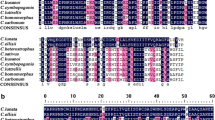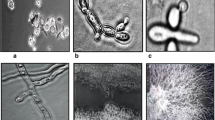Abstract
Gibberella fujikuroi and Gibberella intermedia(mating populations ‘C’ and ‘D’ of the G. fujikuroi species complex) can be distinguished by differences in the spectrum of mycotoxins produced, the lack of sexual cross-fertility and diagnostic differences in their DNA sequences. Some isolates from these two biological species, however, can interbreed and complete meiosis to produce viable progeny. Analysis of marker segregation amongst such hybrid progeny can be used to estimate the degree of genomic rearrangement and genetic incompatibility that has accumulated since these sibling species diverged. Recombinant progeny were isolated from crosses of the standard tester strains for these two species and from crosses between these standard testers and a field isolate (KSU X-10626) that was cross-fertile with tester strains of both species. Progeny in all of the crosses segregated for amplified fragment length polymorphisms (AFLPs). Segregation of AFLP loci deviated from 1:1 for two thirds of the loci amongst the progeny of the cross between the ‘C’ and ‘D’ mating population tester strains, but <20% of the polymorphic loci in the cross of either tester with KSU X-10626 showed such distortion. It was concluded that G. intermedia and G. fujikuroi are sufficiently interfertile to belong to the same biological species, but that changing the nomenclature to reflect this interfertility requires more evidence for the natural occurrence of a continuum in fertility than is presently available.
Similar content being viewed by others
References
Britz H, Coutinho TA, Wingfield MJ, Marasas WFO, Gordon TR and Leslie JF (1999) Fusarium subglutinans f. sp. pini represents a distinct mating population in the Gibberella fujikuroi species complex. Applied and Environmental Microbiology 65: 1198-1201
Bullock S, Willetts HJ and Ashford AE (1980) The structure and histochemistry of sclerotia of Sclerotinia minor Jagger 1. Light and electron microscope studies on sclerotial development. Protoplasma 104: 315-331
Correll JC, Klittich CJR and Leslie JF (1987) Nitrate nonutilizing mutants of Fusarium oxysporum and their use in vegetative compatibility tests. Phytopathology 77: 1640-1646
Desjardins AE, Plattner RD and Nelson PE (1997) Production of fumonisin B1 and moniliformin by Gibberella fujikuroi from rice from various geographic areas. Applied and Environmental Microbiology 63: 1838-1842
Ellis JJ (1988a) Section Liseola of Fusarium. Mycologia 80: 255-258
Ellis JJ (1988b) Lesser known species in section Liseola of Fusarium and near relatives in the Fusarium oxysporum group. Mycologia 80: 734-738
Ellis JJ (1989) An alignment of toxigenic Gibberella strains having anamorphs in section Liseola of Fusarium. Mycologia 81: 307-311
Feder N and O'Brien TP (1968) Plant microtechnique: Some principles and new methods. American Journal of Botany 55: 123-142
Hsieh WH, Smith SN and Snyder WC (1977) Mating groups in Fusarium moniliforme. Phytopathology 67: 1041-1043
Huss MJ, Campbell CL, Jennings DB and Leslie JF (1996) Isozyme variation among biological species in the Gibberella fujikuroi species complex (Fusarium section Liseola). Applied and Environmental Microbiology 62: 3750-3756
Jurgenson JE, Bowden RL, Zeller KA, Leslie JF, Alexander NJ and Plattner RD (2002) A genetic map of Gibberella zeae (Fusarium graminearum). Genetics 160: 1452-1460
Kerényi Z, Zeller KA, Hornok L and Leslie JF (1999) Standardization of mating-type terminology in the Gibberella fujikuroi species complex. Applied and Environmental Microbiology 65: 4071-4076
Klittich CJR and Leslie JF (1988) Nitrate reduction mutants of Fusarium moniliforme (Gibberella fujikuroi). Genetics 118: 417-423
Kuhlman EG (1982) Varieties of Gibberella fujikuroi with anamorphs in Fusarium section Liseola. Mycologia 74: 759-768
Leslie JF (1995) Gibberella fujikuroi: Available populations and variable traits. Canadian Journal of Botany 73(Suppl. 1): S282-S291
Leslie JF and Klein KK (1996) Female fertility and mating-type effects on effective population size and evolution in filamentous fungi. Genetics 144: 557-567
Leslie JF, Pearson CAS, Nelson PE and Toussoun TA (1990) Fusarium species from corn, sorghum, and soybean fields in the central and eastern United States. Phytopathology 80: 343-350
Leslie JF, Zeller KA, Logrieco A, Mulè G, Moretti A and Ritieni A (2004) Species diversity and toxin production by strains in the Gibberella fujikuroi species complex isolated from native prairie grasses in Kansas. Applied and Environmental Microbiology 70
Leslie JF, Zeller KA and Summerell BA (2001) Icebergs and species in populations of Fusarium. Physiological and Molecular Plant Pathology 59: 107-117
Marasas WFO, Rheeder JP, Lamprecht SC, Zeller KA and Leslie JF (2001) Fusarium andiyazi sp. nov., a new species from sorghum. Mycologia 93: 1203-1210
Moretti A, Logrieco A, Bottalico A, Ritieni A, Fogliano V and Randazzo G (1996) Diversity in beauvericin and fusaproliferin production by different populations of Gibberella fujikuroi (Fusarium section Liseola). Sydowia 48: 44-56
Nirenberg HI and O'Donnell K (1998) New Fusarium species and combinations within the Gibberella fujikuroi species complex. Mycologia 90: 434-458
O'Donnell K, Cigelnik E and Nirenberg HI. 1998 Molecular systematics and phylogeography of the Gibberella fujikuroi species complex. Mycologia 90: 465-493
Perkins DD (1994a) Deviations from 1:1 and numbers of progeny necessary for establishing linkage. Fungal Genetics Newsletter 41: 69-70
Perkins DD (1994b) How should the interfertility of interspecies crosses be designated? Mycologia 86: 758-761
Proctor RH, Desjardins AE, Plattner RD and Hohn TM (1999) A polyketide synthase gene required for biosynthesis of fumonisin mycotoxins in Gibberella fujikuroi mating population A. Fungal Genetics and Biology 27: 100-112
Puhalla JE and Spieth PT (1985) A comparison of heterokaryosis and vegetative compatibility among varieties of Gibberella fujikuroi (Fusarium moniliforme). Experimental Mycology 9: 39-47
Rheeder JP, Marasas WFO and Vismer HF (2002) Production of fumonisin analogs by Fusarium species. Applied and Environmental Microbiology 68: 2101-2105
Samuels GJ, Nirenberg HI and Seifert KA (2001) Perithecial species of Fusarium. In: Summerell BA, Leslie JF, Backhouse D, Bryden WL and Burgess LW (eds) Fusarium: Paul E. Nelson Memorial Symposium (pp 1–14) APS Press, St. Paul, MN, USA
Steenkamp ET, Wingfield BD, Coutinho TA, Wingfield MJ and Marasas WFO (1999) Differentiation of Fusarium subglutinans f. sp. pini by histone gene sequence data. Applied and Environmental Microbiology 65: 3401-3406
Steenkamp ET, Wingfield BD, Coutinho TA, Zeller KA, Wingfield MJ, Marasas WFO and Leslie JF (2000) PCR-based identification of MAT-1 and MAT-2 in the Gibberella fujikuroi species complex. Applied and Environmental Microbiology 66: 4378-4382
Summerell BA, Salleh B and Leslie JF (2003) A utilitarian approach to Fusarium identification. Plant Disease 87: 117-128
Tudzynski B (1999) Biosynthesis of gibberellins in Gibberella fujikuroi: Biomolecular aspects. Applied Microbiology and Biotechnology 52: 298-310
Vos P, Hogers R, Bleeker M, Reijans M, van de Lee T, Hornes M, Frijters A, Pot J, Peleman J, Kuiper M and Zabeau M (1995) AFLP: A new technique for DNA fingerprinting. Nucleic Acids Research 23: 4407-4414
Zeller KA, Jurgenson JE, El-Assiuty EM and Leslie JF (2000) Isozyme and amplified fragment length polymorphisms (AFLPs) from Cephalosporium maydis in Egypt. Phytoparasitica 28: 121-130
Zeller KA, Summerell BA, Bullock S and Leslie JF (2003) Gibberella konza (Fusarium konzum) sp. nov., a new biological species within the Gibberella fujikuroi species complex from prairie grass. Mycologia 95: 943-954
Author information
Authors and Affiliations
Corresponding author
Rights and permissions
About this article
Cite this article
Leslie, J.F., Zeller, K.A., Wohler, M. et al. Interfertility of Two Mating Populations in the Gibberella Fujikuroi Species Complex. European Journal of Plant Pathology 110, 611–618 (2004). https://doi.org/10.1023/B:EJPP.0000032400.55446.d8
Issue Date:
DOI: https://doi.org/10.1023/B:EJPP.0000032400.55446.d8




